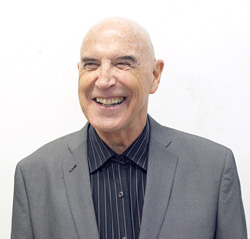NOT IN THE AGE OF THE PHARAOHS
July 6, 2012

Bruce Ferguson was invited to give a talk during the third week of the 18th Biennale of Sydney with the title ‘Not In The Age Of The Pharaohs’.
Four examples of works of art prior to the revolution loosely known as the Arab Spring in Egypt to show how good art is symptomatic of political and societal issues and ills. The talk will include a wide variety of images from the revolution together with a discussion of the issues surrounding the contested word “revolution” as well as references to an Egyptian literature of discontent that preceded the four works by many decades as well as a discussion of the difference between works of art and representations per se.
One of the works of art discussed was by an artist who was assassinated by police forces in Tahrir Square and who has become a forceful symbol of the martyrdom of many other courageous and creative people.
The lecture will be held on Wednesday 11th July , 2012 in the Art Gallery of New South Wales at 7:15pm as part of their Art after hours program following a Biennale exhibition floortalk.
The Biennale of Sydney is an international festival of contemporary art held every two years in Sydney Australia. It is the larges and most attended contemporary visual arts event alongside the Venice, Sao Paolo Biennales, as well as the longest running exhibitions of its kind.
In memory of Nick Waterlo: Nick Waterlow, a curator, academic and writer at the University of New South Wales for many years, died in 2009. Nick was well known and respected expert on the history of art in Australia and was notable for curating at the Biennale of Sydney. He contributed immeasurably to the Australian Arts Community across his lifetime and in celebrating his memory, the Biennale has instituted the position of The Nick Waterlow Curatorial Fellow to honor and continue Nick’s legacy of scholarship to support young and emerging curators.

Talk in Cyprus
July 3, 2011
Bruce W. Ferguson, Dean of the School of Humanities and Social Sciences, American University in Cairo, Egypt has been invited by the Ministry of Education and Culture in Cyprus to act as interpolator the editors of “Biennale Knowledge,” published by the Bergen Kunstmuseum recently and to which Ferguson contributed a co-authored text with Milena Hoegsberg.
Bruce spoke on Tuesday, March 22nd 2011 at a conference entitled “The Biennale Urge”, in conjunction with the retrospective exhibition “Cyprus in Venice, 1968-2009” (40 years of participation in the Venice Biennale of Art). The exhibition and conference took place at the Nicosia Municipal Arts Center (Old Power House), in association with the Pierides Foundation.
Marking 115 years since its inauguration, the Venice Biennale of Visual Arts is still considered to be one of the most significant artistic events on the calendar, and every two years the City of Venice becomes the epicenter of the international art world, the media, and the art- loving public.
Cyprus first joined this massive art celebration in 1968 with six young artists, demonstrating all the cultural and artistic dynamism of a new State. The intractable socio-political circumstances on the island during the following period led to a long absence, until 1986 when the national participation resumed, continuing almost uninterrupted until today, under the responsibility of the Cultural Services of the Ministry of Education and Culture.
This exhibition primarily seeks to acquaint a wider local audience with the institution of the Venice Biennale, and the works of the artists who have represented Cyprus up until today. On another level, it attempts to place these contributions in a historical context, in relation to the course of contemporary art in Cyprus during the post-independence period as well as in relation to the developing course of the biennial. Furthermore, it investigates prevailing narratives and discourses, both within works in the national pavilion and in connection with international debates in theory and criticism; and finally, it collects and reconstitutes ‘lost’ sources and archival material associated with the Cypriot participation, while trying to outline the distinctive profile of the event itself.


